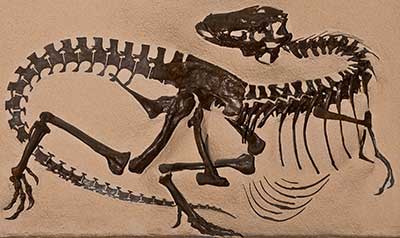Albertosaurus
| Quick Facts | |
|---|---|
| Name Meaning: | Alberta Lizard |
| Distribution: | Northwestern America (Alberta, Montana, etc.) |
| Time Period: | Late Cretaceous, 70 Ma |
| Length: | 35 ft (10.5 m) |
| Weight: | 2.6-3 tons |
| Diet: | Carnivore |
| Linnaean Classification | |
| Kingdom: | Animalia |
| Phylum: | Chordata |
| Class: | Reptilia |
| Superorder: | Dinosauria |
| Order: | Saurischia |
| Suborder: | Theropoda |
| Family: | Tyrannosauridae |
| Genus: | Albertosaurus |
| Cladistic Classification | |
| |

History
The Albertosaurus was first discovered in 1884 by Joseph B. Tyrrell in the Horseshoe Canyon, of Alberta, Canada. At this point, it was classified as being part of a separate species. The Albertosaurus appears similar to severa Tyrannosaurids of its time including its sister fossil the Gorgosaurus. Henry Fairfield Osborn finally named it the Albertosaurus in 1905. The name was given in honor of the location of its first discovery in Alberta, Canada. Later a bonebed was discovered near the original discovery site in 1910. Nine specimens were uncovered in the bonebed. It was later abandoned, however, recently in 1997 it was rediscovered and thirteen more specimens uncovered.
Description
The Albertosaurus looked like a miniature version of the Tyrannosaurus. Like others of its kind it was a bipedal predator, balancing its massive head and s-shaped neck with a long and thick tail. Its jaw held over 60 banana-shaped teeth. It also had short crests above the eyes, which at one point may have been colored and used for display. Its arms, like the Tyrannosaurus, were uselessly small with two clawed fingers on each arm.Lifestyle
The Albertosaurus was a predator that hunted hadrosaurs and other forms of life. It was considered fast for its size at speeds of 25-30 miles per hour. The Albertosaurus may have had pack behavior. This is theorized due to the large concentration of Albertosaurus in the bonebed discovered in 1910. However, it is also possible that these dinosaurs were brought together for reasons of drought or flooding. While herbivores have been known to travel in herds this is more of a rare occurrence in dinosaur predators.
ScienceViews Writer: Jason Hamilton.
Copyright © 2005-2010 Calvin & Rosanna Hamilton. All rights reserved.